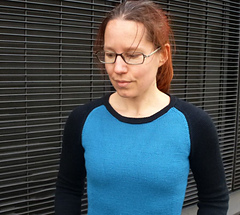patterns >  knitting in spaceships
knitting in spaceships
> N.A.S.T.S.



















N.A.S.T.S.
A raglan pullover with all the details.
2 styles (slim fit / relaxed fit), each in 12 sizes, and lots of optional shaping for your personal perfect fit.
Curved raglan lines create the classic sports shirt look, while bust and waist shaping with vertical darts and optional horizontal darts produces a flattering fit. The curved bottom hem and the sleeve cuffs and neckline are finished with welts and folded hems for a professional flair.
Pattern also contains an interview with Rosy Green Wool (in an extra file).
Sizing / yarn requirements: See bottom picture for detailed sizing and yardage table.
The slim fit version is meant to be worn with ~5 cm / 2 inches of negative ease around the bust and a tight-fitting armhole and upper arm.
The relaxed fit version is meant to be worn with ~2 cm / 1 inch of positive ease around the bust and provides an overall looser fit.
The 12 sizes are grouped into three sets with slightly different proportions, and the pattern contains detailed advice for individual waist and bust shaping.
The sweater is shown in size S3 slim fit on a person with a 84 cm / 33” bust and a 90 cm / 35” hip.
Yarn advice:
The original sweater was knitted with Rosy Green Wool Cheeky Merino Joy (320 m / 350 yds per 100g) in the colours “Laguna” and “Black Cat”. It is worked at a smaller gauge than the manufacturer suggests, for a dense and durable fabric.
The garment can be knitted in a wide range of yarns in heavy 4ply / fingering to sport weight.
Needle advice:
Use the needle size that gives you the required gauge, most likely 2.5 - 3mm / US 1 ½ -2 ½. You will also need a needle one or two sizes smaller.
The garment is partly worked flat and partly in the round. If you want to use the same needle for everything, it is best to use a medium long circular needle (80 - 100 cm / 32 – 40’’). The sleeves can be worked with “magic loop” or with dpns.
Construction:
This pattern employs a combination of bottom up and top down, seamless and seamed knitting, for an efficient knitting experience and the best possible result. The front, back and sleeve parts of the raglan yoke are worked flat, bottom up from underarm level with a provisional cast on. Then these pieces are seamed together, and the lower body and sleeves are worked top down in the round from the same cast on. This sequence might appear overly complicated at first sight, but the raglan decreases produce a neater look than increases. Also, the front neckline is less fussy to work bottom up than top down. Working the lower body and sleeves top down, however, makes it easier to judge the fit and get the length just right.
~~~
Ein Raglanpullover voller Feinheiten.
Zwei Passformen (schlank / locker) jeweils in 12 Größen, und viele Möglichkeiten zur individuellen Anpassung.
Durch geschwungene Raglanlinien entsteht der klassische Sportshirt-Look, die Taillierung mit vertikalen Abnähern sorgt für einen passgenauen Sitz. Die abgerundete Unterkante, die Ärmel und der Halsausschnitt sind mit professionell aussehenden Biesen und gefalteten Säumen abgeschlossen.
Als Bonus enthält die Anleitung ein Interview mit Rosy Green Wool.
Größen / Garnverbrauch: Siehe Tabelle im letzten Bild.
Die schlanke Version ist mit ca. 5 cm Minderweite an der Brust und eng sitzenden Schultern und Ärmeln konzipiert.
Die lockere Version ist für ca. 2 cm Mehrweite an der Brust und eine insgesamt lässigere Passform berechnet.
Die 12 Größen sind in drei Gruppen unterteilt, die sich in ihren Proportionen unterscheiden, und die Anleitung enthält detaillierte Informationen zur individuellen Anpassung der Taillierung.
Die Photos zeigen den Pullover in Größe S3 schlanke Passform an einer Person mit 84 cm Brustumfang und 90 cm Hüftumfang.
Garnhinweise:
Der Originalpullover wurde mit Rosy Green Wool Cheeky Merino Joy (320 m / 100g) in den Farben “Laguna” und “Black Cat” gestrickt. Es wird eine etwas kleinere Maschenprobe verwendet als vom Hersteller empfohlen, um ein dichtes und haltbares Gestrick zu erzielen. Die Anleitung eignet sich für eine breite Palette an Garnen in Sockenwollstärke und etwas dicker.
Nadeln:
Verwende die Nadelstärke, mit der die angegebene Maschenprobe erreicht wird, wahrscheinlich 2.5 - 3mm. Es wird auch eine Nadel benötigt, die ein bis zwei Größen kleiner ist.
Der Pullover wird teilweise flach und teilweise in der Runde gestrickt. Wenn man für alles die gleiche Nadel verwenden will, empfiehlt sich eine mittellange Rundstricknadel (80 – 100 cm). Die Ärmel können mit “magic loop” oder mit Sockennadeln gestrickt werden.
Konstruktion:
Diese Anleitung arbeitet mit einer Kombination aus genähten und nahtlos gestrickten Abschnitten, teils von oben, teils von unten gearbeitet, um mit einer möglichst effizienten Methode das bestmögliche Ergebnis zu erreichen. Das Vorderteil, Rückenteil und die Ärmelteile der Raglanpasse werden jeweils mit einem provisorischen Anschlag auf Oberbrusthöhe begonnen und flach
nach oben gestrickt. Anschließend werden sie zusammengenäht und der untere Teil des Körpers und der Ärmel werden in der Runde nach unten weitergestrickt. Diese Konstruktion mag auf den ersten Blick übermäßig kompliziert erscheinen, aber Raglanabnahmen sind optisch schöner als Zunahmen, und der Halsausschnitt ist auf diese Weise auch einfacher zu arbeiten. Indem jedoch der untere Teil in der Runde nach unten gestrickt wird, ist es einfacher, die Länge und Passform der Ärmel und des Körpers zu beurteilen.
9670 projects
stashed
8716 times
- First published: February 2017
- Page created: February 12, 2017
- Last updated: February 2, 2023 …
- visits in the last 24 hours
- visitors right now





